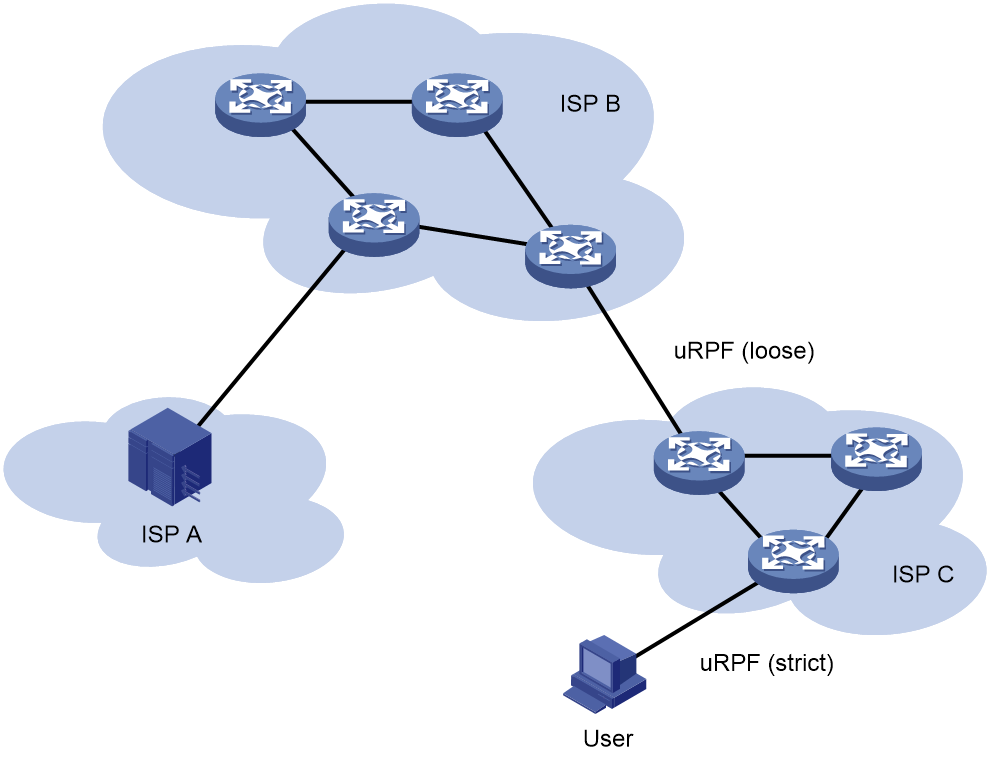- Table of Contents
-
- 14-Security Configuration Guide
- 00-Preface
- 01-Keychain configuration
- 02-Public key management
- 03-PKI configuration
- 04-SSH configuration
- 05-SSL configuration
- 06-Packet filter configuration
- 07-DHCP snooping configuration
- 08-DHCPv6 snooping configuration
- 09-ARP attack protection configuration
- 10-ND attack defense configuration
- 11-Attack detection and prevention configuration
- 12-uRPF configuration
- 13-IP source guard configuration
- 14-Crypto engine configuration
- Related Documents
-
| Title | Size | Download |
|---|---|---|
| 12-uRPF configuration | 85.18 KB |
Configuring uRPF
About uRPF
Unicast Reverse Path Forwarding (uRPF) protects a network against source address spoofing attacks, such as DoS and DDoS attacks.
uRPF application scenario
Attackers send packets with a forged source address to access a system that uses IPv4-based authentication, in the name of authorized users or even the administrator. Even if the attackers or other hosts cannot receive any response packets, the attacks are still disruptive to the attacked target.
Figure 1 Source address spoofing attack
As shown in Figure 1, an attacker on Device A sends the server (Device B) requests with a forged source IP address 2.2.2.1 at a high rate. Device B sends response packets to IP address 2.2.2.1 (Device C). Consequently, both Device B and Device C are attacked. If the administrator disconnects Device C by mistake, the network service is interrupted.
Attackers can also send packets with different forged source addresses or attack multiple servers simultaneously to block connections or even break down the network.
uRPF can prevent these source address spoofing attacks. It checks whether an interface that receives a packet is the output interface of the FIB entry that matches the source address of the packet. If not, uRPF considers it a spoofing attack and discards the packet.
uRPF check modes
uRPF supports strict and loose modes.
Strict uRPF check
To pass strict uRPF check, the source address of a packet and the receiving interface must match the destination address and output interface of a FIB entry. In some scenarios (for example, asymmetrical routing), strict uRPF might discard valid packets.
Strict uRPF is often deployed between a PE and a CE.
Loose uRPF check
To pass loose uRPF check, the source address of a packet must match the destination address of a FIB entry. Loose uRPF can avoid discarding valid packets, but might let go attack packets.
Loose uRPF is often deployed between ISPs, especially in asymmetrical routing.
Network application
As shown in Figure 2, strict uRPF check is configured between an ISP network and a customer network. Loose uRPF check is configured between ISPs.
Restrictions and guidelines: uRPF configuration
If you enable uRPF on an interface, you can use the display ip interface command to display statistics about packets discarded by uRPF (displayed as "Drops" and "Suppressed drops"). If you enable uRPF globally, the system does not provide statistics about packets discarded by uRPF.
If you configure uRPF globally and on an interface, the interface preferentially uses the interface-specific settings.
Enabling uRPF globally
Restrictions and guidelines
Global uRPF takes effect on all interfaces of the device.
Procedure
1. Enter system view.
system-view
2. Enable uRPF globally.
ip urpf { loose | strict }
By default, uRPF is disabled.
Enabling uRPF on an interface
1. Enter system view.
system-view
2. Enter interface view.
interface interface-type interface-number
3. Enable uRPF.
ip urpf { loose | strict }
By default, uRPF is disabled.
Verifying and maintaining uRPF
To display uRPF configuration, execute the following command in any view:
display ip urpf [ interface interface-type interface-number ] [ slot slot-number ]



